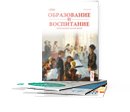Virtual classrooms and interactive tools have transformed foreign language learning, making it more dynamic, flexible, and immersive. AI-driven technologies enhance engagement, personalization, and real-time interaction, while multimedia and collaborative tools improve retention and comprehension. This article highlights the cognitive and pedagogical benefits of virtual learning, advocating for a blended approach that integrates innovation with traditional teaching.
Keywords: virtual classrooms, foreign language learning, interactive tools, digital education, artificial intelligence in education, immersive learning, adaptive learning technology, multimedia resources.
The integration of digital technologies in education has revolutionized foreign language instruction. Virtual classrooms and interactive tools create dynamic and engaging learning environments that extend beyond traditional classroom boundaries. Research suggests that digital learning complements, and often surpasses, traditional methods in facilitating language acquisition, cognitive engagement, and personalized learning experiences.
One major advantage of virtual classrooms is their ability to structure lessons for optimal cognitive efficiency. Clark and Paivio highlight the importance of combining verbal and visual representations for enhanced learning [1]. Cobb argues that media technologies enhance learning by reducing cognitive load and structuring information effectively, aiding students in processing and retaining knowledge [2]. This aligns with Collins, Brown, and Holum’s cognitive apprenticeship theory, emphasizing the importance of making thinking processes visible in digital learning environments [3]. Craik and Lockhart’s levels of processing theory suggest that deeper cognitive engagement improves memory retention [4]. Virtual classrooms enhance this through interactive exercises, multimedia content, and real-time feedback, requiring active participation. The inclusion of videos, animations, and gamified learning ensures students actively construct knowledge, strengthening linguistic proficiency. Despite concerns about screen fatigue, well-structured digital content prevents cognitive overload. Cobb notes that virtual classrooms present information in manageable chunks, facilitating efficient linguistic structure absorption [2].
Another key advantage is access to authentic language use. Traditional classrooms rely on controlled dialogues and textbook exercises, whereas digital platforms offer diverse linguistic content, such as news articles, podcasts, films, and social media. This exposure enhances learners' understanding of accents, dialects, and cultural nuances. Virtual classrooms also provide opportunities for interaction with native speakers through language exchange platforms, virtual conversation groups, and AI-driven tutors. These immersive experiences improve linguistic competence and cultural understanding, making language learning more effective and inclusive.
Collaboration is crucial for effective language learning, and virtual classrooms facilitate interactive engagement. Fåhræus et al. highlight that electronic collaborative learning groups enable knowledge-sharing and communication skill development in authentic contexts [5]. Unlike traditional settings, digital platforms allow real-time peer feedback, joint projects, and discussion forums, encouraging active language use. Social learning theories support the importance of interaction in language acquisition. Vygotsky posits that learners develop higher-order cognitive skills when engaging with more knowledgeable peers or instructors in a Zone of Proximal Development (ZPD) [6]. Virtual classrooms enable this through structured group activities, real-time discussions, and mentorship programs. Wenger’s communities of practice concept reinforce this, emphasizing meaningful language learning through goal-directed communication in social contexts [7]. Hatcher explores how online education enhances metacommunicative skills, helping learners interpret implicit meanings in digital interactions [8]. The ability to decode subtleties in communication is essential for language mastery, and virtual classrooms provide ample opportunities for refining this skill.
Artificial intelligence (AI) is increasingly shaping virtual language education. AI-driven tools, such as chatbots and speech recognition software, offer interactive, real-time simulations tailored to individual proficiency levels. These tools analyze learners’ input, provide instant corrections, and generate personalized exercises based on strengths and weaknesses. Lu highlights that AI-enhanced learning systems deliver targeted feedback on pronunciation, grammar, and vocabulary, allowing students to refine their linguistic skills more efficiently [9]. AI-powered speech recognition aids learners in mastering intonation, stress patterns, and rhythm—aspects often difficult to perfect without native speaker interaction. Knowles supports self-directed learning models, emphasizing that adult learners benefit from personalized instruction aligned with their needs and schedules [10]. Virtual classrooms, equipped with AI-driven analytics and adaptive learning technologies, offer customized lesson plans tailored to students’ proficiency levels and learning goals. However, Salomon cautions that technology must be strategically implemented to maximize educational potential [11]. While AI and data analytics enhance language learning, they should complement, not replace, human instruction. The most effective approach is a blended model that integrates AI-driven personalization with expert educator guidance.
Virtual classrooms and interactive tools have transformed foreign language education by leveraging multimedia resources, social interactions, and adaptive learning technologies. Digital platforms enhance cognitive efficiency, provide authentic language exposure, promote collaborative learning, and enable AI-driven personalization. However, the most effective learning model is a blended approach, combining digital and face-to-face instruction. As educational technology evolves, language educators must thoughtfully integrate digital tools to enhance, rather than replace, human-centered learning. The future of foreign language education lies in adaptive, immersive, and socially interactive learning experiences that empower students to become confident global communicators.
References:
- Clark J. M., Paivio A. Dual Coding Theory and Education // Educational Psychology Review. 1991. Vol. 3, No. 3. P. 149–170.
- Cobb T. Cognitive Efficiency: Toward a Revised Theory of Media // Educational Technology Research and Development. 1997. Vol. 45, No. 4. P. 21–35.
- Collins A., Brown J. S., Holum A. Cognitive Apprenticeship: Making Thinking Visible // American Educator. 1991. Vol. 6, No. 11. P. 38–46.
- Craik F. I. M., Lockhart R. S. Levels of Processing // Journal of Verbal Learning and Verbal Behavior. 1972. Vol. 11. P. 671–684.
- Fåhræus E. R. et al. Teaching with Electronic Collaborative Learning Groups // ITiCSE'99 Working Group Report. ACM. 1999. P. 121–128.
- Vygotsky L. S. Mind in Society: The Development of Higher Psychological Processes. Cambridge: Harvard University Press, 1978.
- Wenger E. Communities of Practice: Learning, Meaning, and Identity. Cambridge: Cambridge University Press, 1998.
- Hatcher S. Reading Between the Lines // American Psychological Association Annual Conference. 2003. P. 1–11.
- Lu X. AI-Driven Learning: Enhancing Foreign Language Acquisition through Real-Time Feedback // Journal of Educational Technology. 2022. Vol. 18, No. 2. P. 45–67.
- Knowles M. The Adult Learner: A Neglected Species. Gulf Publishing, 1984.
- Salomon G. Interaction of Media, Cognition, and Learning: An Exploration of How Symbolic Forms Cultivate Mental Skills. Erlbaum, 1994.







